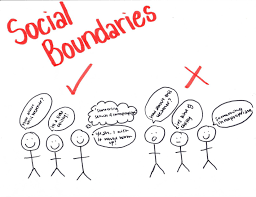Conversely, if allgroup-members are to equally share the reward for a collectively performedtask, group identification shall be enhanced. When the differencebetween self and fellow group-members is accentuated, we are doubtless toobserve selfish motives and self-favoritism against othergroup-members. When instead group identification is enhanced, in-groupfavoritism towards out-group members will be activated, as properly asbehavior opposite to self-interest. Thibaut and Kelley’s (1959) view of norms as substitutes forinformal influence has an analogous functionalist flavor. In this sport, somebargaining is critical for every celebration to acquire, at leastoccasionally, the preferred outcome.
If you look around a college classroom you’ll probably see students engaging in studious behavior, taking notes, listening to the professor, studying the textbook, and sitting quietly at their desks (link). Of course you may even see students deviating from the anticipated studious habits corresponding to texting on their telephones or utilizing Facebook on their laptops, however in all instances, the students that you just observe are attending class—a part of the social position of scholars. If you look around a college classroom you’ll likely see college students participating in studious behavior, taking notes, listening to the professor, studying the textbook, and sitting quietly at their desks (Figure 12.8). If you go searching a college classroom you will likely see students participating in studious habits, taking notes, listening to the professor, reading the textbook, and sitting quietly at their desks (Figure 1). Social norms are the unwritten guidelines and expectations that dictate how individuals ought to behave in particular contexts or situations, shaping group behavior. In contrast, social roles are the specific positions individuals occupy within a gaggle, every with its personal set of anticipated behaviors and obligations.
- A Lot of this inquiry relies on position concept, because it posits that assuming roles is a supply of energy, status, and resources, which subsequently result in well being advantages for individuals.
- Furthermore, though aparticular norm may persist (as against emerge) due to somepositive social perform it fulfills, there are tons of others that areinefficient and even extensively unpopular.
- This might assist researchers to further understand the training processes, i.e., from the detection of social cues in the pre-learning stage, to constantly adjusting behaviors in accordance with social feedback, and internalization of the brand new norm.
- Nonetheless, when getting into into a new scenario or culture, persons are often exposed to a big selection of unfamiliar, ambiguous, implicit guidelines and norms, most of that are unwritten and situation-dependent social norms.
- Nonetheless, a quantity of elements of the examine have been subject to criticism since its inception.
In South America, In Distinction, Persons Are Expected To (young, :
In the following part, we examine these two constructs in higher depth and offer a trans‐disciplinary definition of gender norms to help unite the field. Regardless Of the historic interest of gender students and activists on gender norms, theoretical work on gender diversified within the 2010s, with the rise of queer studies and transgender activism. Discourse on gender norms and gender as a social system started to coexist with competing understandings of gender as a deeply held psychological sense of oneself as both a man, a lady or something in between. Popular use of the time period additionally modified, as individuals began to substitute the word gender for sex, shedding the important distinction between biology and social construction. While reviewing the entire thing of this literature is past the scope of this article, Heise et al. (2019) recently reviewed how understandings of how gender have diversified over time, with implications for efforts to extend people’s well being. The successful discount of feminine genital chopping in Senegal through strategies in preserving with social norms principle is a working example (Mackie 1996, Mackie and Lejeune 2009).
In this section, we examine situational forces that have a powerful affect on human conduct together with social roles, social norms, and scripts. We focus on how people use the social environment as a supply of knowledge, or cues, on tips on how to behave. Situational influences on our behavior have essential consequences, similar to whether we will help a stranger in an emergency or how we would behave in an unfamiliar environment.
The situational sources mainly include place (where a social norm takes place), event (which devotes to a social norm), group (to which learners belong), and culture (which displays macro-level contextual factors). Contemplating the importance of learning new social norms on sociocultural adaption to a changeable environment and a fresh cultural context, we evaluate earlier literature on social norms and various kinds of studying to supply a possible theoretic framework for social norm studying. We first begin with distinguishing the distinctive features and the significance of social norms from different kinds of norms.

Creating Shared Meanings:
Additionally, it’s important to explore how societal components work together with private traits/preferences to impression learning-related processes uniquely or jointly. First, social norm learning requires social cognition, corresponding to sharing and understanding others’ mental states and behaviors (Legros and Cislaghi, 2020), reflecting learners’ ability to interact with others. Relating To social norm studying, much less is achieved strictly from private experience, whereas extra is acquired from related others (Bossan et al., 2015).

Much attention has instead beenpaid to the conditions underneath which norms might be obeyed. Because ofthat, the difficulty of sanctions has been paramount in the socialscience literature. Furthermore, since social norms are seen as centralto the manufacturing of social order or social coordination, analysis onnorms has been targeted on the capabilities they carry out. Yeteven if a norm might fulfill essential social capabilities (such as welfaremaximization or the elimination of externalities), it can not beexplained solely on the basis of the features it performs.

The challenge thusbecomes one of explaining the dynamics of the norm propagation fromsmall groups to large populations. While folks have been universally equipped with the power to learn social norms, it’s little question that this ability varies across people and teams. For instance, cross-cultural proof showed that cultural tightness predicts larger sensitivity to norm-violation habits (Mu et al., 2015).
On theother hand, this interpretation of social norms doesn’t primafacie explain why folks prefer to adapt if they anticipate othersto conform. Internalization is a key factor of socialization whereby one follows a certain social norm from one’s personal internalized motive somewhat than out of external surveillance or sanction (Etzioni, 2000; Bell and Cox, 2015; Morris et al., 2015; Dannals and Miller, 2017). That is, individuals observe the new social norm even when others round them do not obey it after internalizing it. Nevertheless, how a model new social norm may be stored and represented internally remains unclear. First, for individuals who regard this social norm as their values (Anderson, 2000; Bell and Cox, 2015), the new social norm could be integrated into the earlier system related to their private and moral values. Second, a brand new social norm may be https://www.simple-accounting.org/ viewed as a illustration of what “the majority” does.
Scripts
Policy makers and practitioners also have to develop group interventions that reach a broad spectrum of older adults. Third, the meaning (or significance) of a job is defined throughout the context of cultural and historic background. Extra cross-cultural research should be performed to find a way to look at the extent to which a given position is valued in numerous societies. Finally, on condition that roles are basically social shaped and maintained, future studies must look at the assorted elements of roles partners (e.g., relationship high quality, variety of function partners, perceived help, and adjustments in partnership). To advance cross‐theoretical work for gender equity and health, there’s need to reconcile understanding of norms from the gender equality and social psychology literature. Higher conceptual clarity would facilitate cross‐disciplinary understanding and collaboration in well being promotion follow in low‐ and middle‐income international locations.


